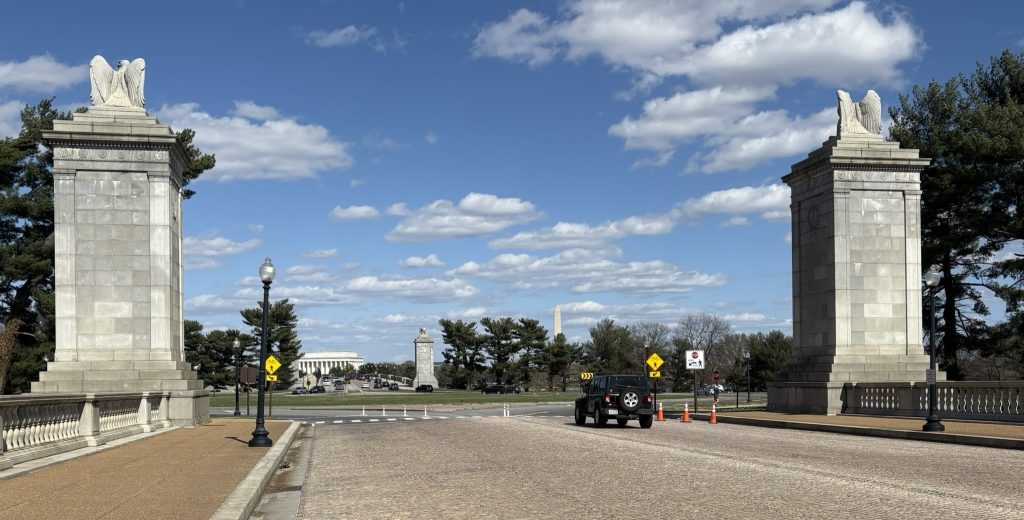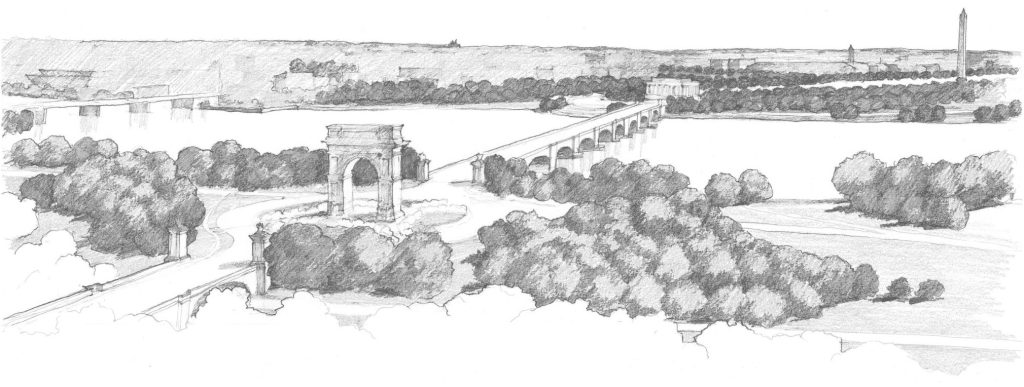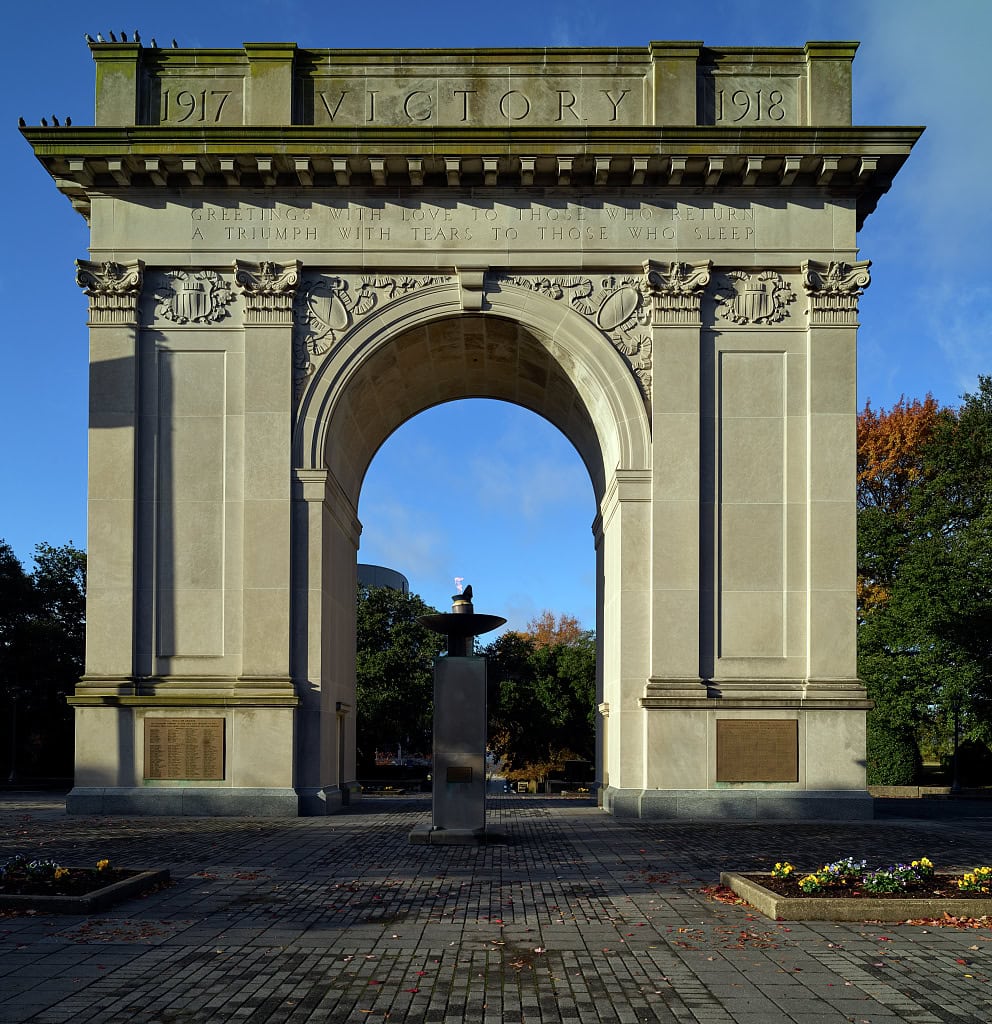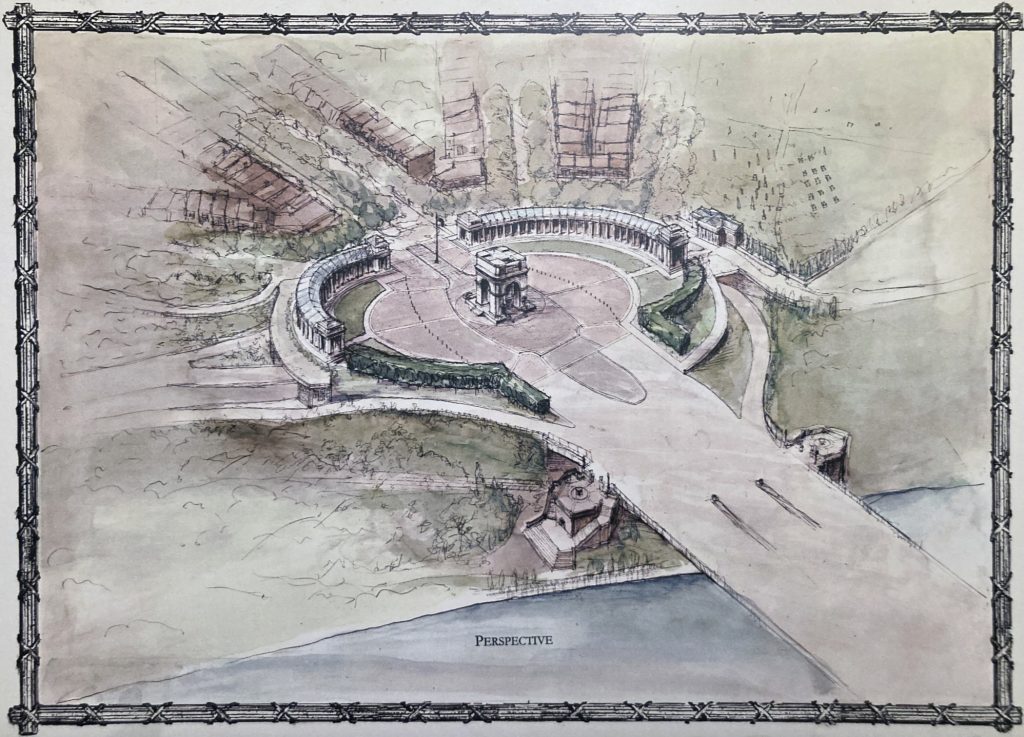A proposal worthy of the nation’s 250th birthday.
The triumphal arch holds a very important place in the annals of Western architecture and urbanism. In Roman times it played a lofty honorific role, even though most Roman arches commemorated civic achievements and personages rather than military victories. The freestanding monumental arch was a syncretic creation, structurally derived from Etruscan gateways and decoratively enriched with Hellenistic architectural and sculptural forms. Its distinctive presence, which accommodated an astonishing variety in massing and detail, enriched towns and cities across the Roman empire, from Spain to Syria.
The monumental arch should be regarded as a universal entity—eminently appropriate, one would think, to a universal nation like these United States. The late, great historian of imperial Roman architecture, William L. MacDonald, noted how the arch corresponds to the classical concept of human proportions as delineated in Leonardo da Vinci’s Vitruvian Man, in which a male figure is inscribed within an overlapping circle and square. The impost or “springing” of the opening within the arch corresponds, MacDonald noted, to the Vitruvian Man’s arms extended directly outward, while the curvilinear opening itself corresponds to his arms sweeping upward. The arch’s geometry thus addresses us as embodied beings. You can’t get more universal than that.
Which brings us to the need for a monumental arch commemorating the semiquincentennial anniversary of the Declaration of Independence—an event of universal significance—in our nation’s capital. President Trump has declared his intention to re-establish the primacy of the classical tradition in Washington’s public architecture. A temporary Independence Arch would be the ideal place to start.
There is not enough time to erect a permanent one by July 4, 2026, but the temporary arch should be considered a forerunner—a trial run, if you like—for a permanent replacement. There is a significant, if largely forgotten, tradition of temporary arches in this country. It was most directly inherited from Europe, but its ancient origin was always borne in mind, not least in the early years of the republic.
When, late in 1783, the Pennsylvania General Assembly commissioned the prominent artist Charles Willson Peale to create a temporary arch in Philadelphia celebrating the Revolutionary War’s victorious conclusion, it called for a monument “exactly in the stile [sic] of the triumphal arches among the Romans.”
In his magisterial Architecture of the Roman Empire: An Urban Appraisal (1986), MacDonald observed that the arch is “a mechanism of transit and transition. It sharply marks a division between two areas or places without sealing off either…. The archway proper…suggests the presence beyond of a place different from that before it.” Of course, this principle applies to time as well as space where the monumental commemoration of American independence is concerned.
Where to put the arch? The most important monumental axis in the United States extends westward from the Capitol to the National Mall, Washington Monument, and Lincoln Memorial before deflecting to the southwest across Arlington Memorial Bridge and down Memorial Avenue to Arlington National Cemetery’s granite Hemicycle. Roadways leading into the cemetery branch off to right and left in front of the Hemicycle.


There is a conspicuous dead space that marks a transition in this grand axis. Between the bridge and Memorial Avenue lies a patch of turf about a hundred yards in diameter, enclosed by a traffic circle. This turfed expanse is surrounded by four eagle-crowned pylons 43 feet tall, two at the southwestern end of the bridge and the other two at the entrance to Memorial Avenue. As has long been recognized, this circular expanse needs an arch.
An Independence Arch need not be huge. The pairs of pylons are spaced 85 feet from one another across the bridge and across the avenue. Gibson Worsham, a veteran architect at the Richmond, Virginia, firm of Glavé & Holmes, with whom I recently visited the site, says an arch 60 feet in height and width and 30 feet in depth might achieve the necessary monumental scale.
A handsome Victory Arch in Newport News, Virginia’s historic downtown, originally erected in 1919 of wood and stucco and replicated in stone decades later, is 50 feet in height and width. Worsham estimates that a temporary arch, this one steel-framed, could be erected at the rotary circle for $15 million. It would stand for a few years at least, or possibly a few decades.

The big challenge is time. If the arch is to be completed by the semiquincentennial, a presidential executive order mandating its construction at the circle, which is located on federal land, needs to be issued very soon. The order might name a top-tier classical architect to preside over the selection of a design team including an architect, sculptor, and builder by this coming July 4. The architect should consult with other professionals with relevant experience, but the final choice of a team should be up to him or her. The design team would have a year to design, build, and decorate the temporary arch, which might or might not bear a close resemblance to a permanent Independence Arch. The sculptural treatment of a permanent arch would presumably be more elaborate, perhaps featuring an emperor-like Liberty figure driving a four-horsed chariot, or quadriga, at its summit.
Washington is the only major Western capital without a monumental arch. There were more than 50 in ancient Rome and hundreds more throughout its empire. In addition to the Independence Arch, a Constitution Arch should be erected at an important axial transition point on the other side of town to celebrate the semiquincentennial of the Constitution’s ratification in 1789. The site is Barney Circle, located about a mile and a half southeast of the Capitol on Pennsylvania Avenue, where the avenue meets the Anacostia River and the John Philip Sousa Bridge. This presently tangled, amorphous site—its name notwithstanding—is an important traffic node next door to Congressional Cemetery, a National Historic Landmark established in 1807, as well as a riverwalk trail along the Anacostia.
Decades ago, the National Monuments Foundation, headed by Rodney Mims Cook, Jr., proposed a quadrifrontal arch for the site to mark the new millennium. The plan calls for curved porticos framing the arch and surrounding realigned roadway, and an imposing new cemetery entrance replacing unsightly chain-link fencing. It also includes handsome, fountain-crowned stone bastions on each side of the avenue where it meets the bridge, one of them incorporating elegant balustraded stairways down to the river trail.

Barney Circle is city-owned turf. The National Monuments Foundation’s plan for the site, which was shelved amidst the post-9/11 uproar, would enhance a monumentally underserved portion of the most important avenue in Pierre Charles L’Enfant’s great plan of 1791, while attracting amenities, pedestrians, hikers, and bicyclists—tourists and locals alike—to the riverside.
A Barney Circle arch would make an excellent monument to the Constitution. Let’s hope D.C. officials and culturally attuned congressmen will work together to realize the Foundation’s exemplary vision for an improved public realm. And let’s hope President Trump mandates an Independence Arch that shows them the way.















